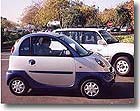by Jacquelyn A. Ottman and Dan Sturges
Fords recent announcement to end production of its Th!nk Mobility line of electric powered Neighborhood Electric Vehicles (NEVs) has caused quite a stir in the green business community. Emotions range from slashed hopes and frustration to outright cynicism. Questions abound.
Do electric vehicles, as the company maintains, really represent too small a niche for a company the size of Ford? Despite what appears to be a strong personal commitment to sustainability by Bill Ford Jr. and no doubt many others at Ford, are the companys precious resources in these tough times better spent figuring out how to power conventional vehicles with fuel cells and hybrids? Regardless of what Ford did right or wrong, was Th!nk from the start destined for the Green Graveyard, buried alongside the likes of Mobils Hefty trashbags, GEs Energy Choice light bulbs and Deja Recycled Shoes, due to consumer reluctance to pay a premium for green? 
Lest the reader think the demise of Th!nk represents another instance of consumers failing to vote green with their pocketbooks, think again. The market for small, fuel efficient, and electric cars within that, seems to be alive and well. We suspect the demise of Th!nk may say more about Fords current financial position and what can go wrong when behemoths attempt to radically innovate, than reluctance on consumers parts.
Much more is on the line than one companys lost eco-innovation and reputation. Th!nks demise represents a timely opportunity to take a step back, to analyze what it takes to market fuel efficient carsand more importantly, what we all need to keep in mind if we are serious about supporting sustainable innovation as a nation and a society.
Meet Real Needs
The bubble look, and price of Thinks City Car, with a 50 mile per charge driving range, just may not have hit the mark to entice leasees. For example, its lease price of $200 a month in its NY Metro area test market may have been too high a price to pay considering one can lease a Honda Civicwith extended driving range for about the same price.
By combining electric with combustion engine technology under one roof (hybrid electric), Toyota and Honda have figured out how to address consumer needs for conventional styling, fuel-efficiency, low emissions, and extended driving range. Whats more, Toyota, who brags they are turning a profit on the 300,000 Priuss sold to date around the world, claims it also delivers a superior quiet ride. Honda recently added a hybrid version to its popular Civic line.
In Europe, the diesel-fueled Micro Compact Car (MCC), founded by Mercedez-Benz and the creator of Swatch watches, is giving consumers what they want: a $10,000 price tag, 69 mpg, easy parking, and a fun experience. Owners can change the colors of side panels at the drop of a hat; slogans like Reduce to the Max woo buyers, and enthusiasm is generated by stacks of colorful cars, displayed Matchbox-like in glass towers in several European cities. 110,000 cars have been sold to date, and Daimler-Chrysler, the new owner, is on track to achieve profitability by 2004.
Think Like A System
Given the limited driving range, what pure electric vehicles like Th!nk do best is provide emissions-free and fuel efficient mobility for short distances. Thats why the technology well serves particular applications like transporting golfers around courses, workers around campuses, and the disabled and infirm inside of enclosed spaces like airports.
If cars could be slotted into Darwinian-type niches, electric vehicles would find a cozy but growing spot ideally suited for short hauls, and within a larger system designed to serve the needs of the consumer for convenient, affordable mobility, clean air, and pleasant communities.
This is what Budget Rent-A-Car discovered when they made electric cars available for rental to environmentally conscious businesspeople at LAX airport, and now they say they cant buy enough of the Toyota RAV4-EV, the only electric suitable for highway use, to satisfy the demand.
This same niche opportunity is being seized by Global Electric Motors (GEM), a Fargo, Nebraska-based start-up and leading manufacturer of NEVs in the U.S., now owned by Daimler-Chrysler. GEM cars are positioned as feeders in car sharing schemes like Seattles Flexcar and Bostons Zipcar that are cropping up around the U.S. They also play a role as part of the transportation systems in planned communities including DC Ranch in Scottsdale, Arizona, Celebration in Florida, and Bay Harbor in Michigan.
Playa Vista, a community in Los Angeles, recently selected GEM and a companion company, eMotion Mobility, to develop what promises to be the most comprehensive zero-emission vehicle mobility system in the nation. This program envisions the wide use of an array of GEM NEVs for passenger and utility purposes as well as zero-emission trams to canvass the property. Certain vehicles would be shared among residents and businesses through an Internet reservations system or by calling a toll-free number.
Th!nk Mobility positioned their City car as a connector to suburban transportation systems. Was this the right niche?
Think Differently
Fords 1999 launch of Th!nk seemed headed in the right direction: a spirited philosophy for a new kind of transportation system; a repositioning of the company as a leader in sustainable mobility. So what went wrong with Th!nk? Was Ford too late to the party? Did its marketing fail to capture consumers imagination? In the U.S., where big equates with safe and gasoline prices are relatively cheap, this may take some doing.
The Th!nk portfolio, primarily offered through dealerships, consisted of a City EV, a golf cart-like Neighbor EV, and two electric bikes. Did such mission-specific vehicles require a different approach to sales? Rather than choosing a former engineer for the Explorer regardless of how successful and innovativeto head the Th!ink Mobility division, might they have been better served by someone outside the industry, say from communications or even the weight loss industry with its emphasis on behavior change? In short, Did Th!nk think differently enough?
Persevere
Successful eco-innovation, like any radical innovation takes perseverance. With the help of its suppliers, MCC, which has already invested over a billion dollars, can afford to hold out until 2004 until it makes its first projected profit, and it continues to invest in new styles and models. Daimler-Chrysler continues to support growth of GEM. For sure, the company that brought us the Mustang and the Taurusindeed, the company that ushered in an entire new era in mobility a century agocertainly has the smarts to figure such things out as strategic positioning and creative marketing. Ford lost $5 billion last ye
ar. In better times, they might even have had the power to muscle in on early competitors and to persevere until markets develop more fully and profits can be made.
Things to Think About
The demise of Th!nk begs much larger questions, however. Our current system of mobility needs to be changed. We dont need more cars on the road capable of being driven endlessly, even at higher levels of fuel efficiency. We need a system that reduces traffic jams, helps transit become more effective, and provides low cost mobility.
Th!nk provided the playing pieces but no game board. However, is it really up to individual companies, no matter how large or storied, to foot the bill for changing the system? Can we create a mechanism by which various societal stakeholders take on the holistic challenges together?
Ford finds itself in a quandary representative of many well-intended sustainability leaders: how do we get from here to there while still making a profit? With competition from Europe and Japan aggressively leveraging the environment as a source for eco-innovation and potentially driving us out of critical world marketswe all have a stake in the outcome.
The early death of Th!nk represents a greater loss to Ford than meets the eye. Ford has missed out on opportunities to begin the transformation to a new kind of transportation company; to provide their 400,000 employees with a much needed morale boost; and to gain access to new markets here in the U.S. and abroad. We extend our support to the thousands of Ford employees who must be as disappointed and frustrated as we are in the green business community. If our collective resolve to address the challenges is as strong as the hope Th!nk originally embodied, well all be able to think once again that the prospects for a truly sustainable future will be bright indeed.
++++
More reading on the subject:
San Francisco Chronicle:
Bush Hits State’s Emission Rules, He Backs Carmakers In Lawsuit
Pulling the Plug: Carmakers Scrap Electric Vehicles
| Jacquelyn Ottman is president, J. Ottman Consulting, Inc. and author, Green Marketing: Opportunity for Innovation. She is keynote speaker this month’s Towards Sustainable Product Design 7 conference in London. Contact her: jottman@greenmarketing.com Dan Sturges, is director of Mobility Lab, which serves as a resource for communities designing sustainable transportation. Contact him: dan@mobilitylab.org |
An earlier version of this article appeared in “The Ottman Report on Green Marketing and Eco-Innovation.” You can sign up to receive a free quarterly subscription at www.greenmarketing.com.
